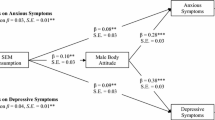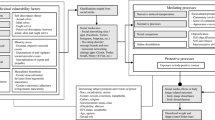Abstract
Limited research has investigated the perceived influence of sexually explicit online media (SEOM) on body satisfaction and partner expectations of men who have sex with men (MSM). Semi-structured qualitative interviews were conducted with 16 MSM, covering the perceived influence of MSM-specific SEOM. All nine men who broached the topics of body satisfaction and partner expectations reported that MSM-specific SEOM set unreasonably high physical appearance expectations for themselves and/or their potential partners. Although MSM-specific SEOM might be negatively affecting body satisfaction and partner expectations among MSM, its ubiquity may make it a useful tool to support body positivity.
Similar content being viewed by others
References
Cash, T. F. (2002). A “negative body image”: evaluating epidemiological evidence. In T. F. Cash & T. Pruzinsky (Eds.), Body image: A handbook of theory, research, and clinical practice (pp. 269–276). New York: Guilford Press.
Centers for Disease Control and Prevention. (2016). Gateway to health communication & social marketing practice: Campaigns. Retrieved from http://www.cdc.gov/healthcommunication/campaigns/index.html
Duggan, S. J., & McCreary, D. R. (2004). Body image, eating disorders, and the drive for muscularity in gay and heterosexual men: the influence of media images. Journal of Homosexuality, 47, 45–58. doi:10.1300/J082v47n03_03.
Glaser, B., & Strauss, A. (1967). Discovery of Grounded Theory: Strategies for Qualitative Research. Chicago, IL: Aldine.
Hald, G. M., Smolenski, D., & Rosser, B. R. S. (2013). Perceived effects of sexually explicit media among men who have sex with men and psychometric properties of the Pornography Consumption Effects Scale (PCES). The Journal of Sexual Medicine, 10, 757–767. doi:10.1111/j.1743-6109.2012.02988.x.
Kubicek, K., Carpineto, J., McDavitt, B., Weiss, G., & Kipke, M. D. (2011). Use and perceptions of the internet for sexual information and partners: a study of young men who have sex with men. Archives of Sexual Behavior, 40, 803–816. doi:10.1007/s10508-010-9666-4.
Martins, Y., Tiggemann, M., & Kirkbride, A. (2007). Those speedos become them: the role of self-objectification in gay and heterosexual men’s body image. Personality and Social Psychology Bulletin, 33, 634–647. doi:10.1177/0146167206297403.
Miles, M. B., & Huberman, A. M. (1994). Qualitative data analysis: an expanded sourcebook. SAGE.
Morrison, T. G. (2004). “He was treating me like trash, and I was loving it …” Perspectives on gay male pornography. Journal of Homosexuality, 47, 167–183. doi:10.1300/J082v47n03_09.
Nelson, K. M., & Carey, M. P. (2016). Media literacy is an essential component of HIV prevention for young men who have sex with men. Archives of Sexual Behavior, 45, 787–788.
Nelson, K. M., Leickly, E., Yang, J. P., Pereira, A., & Simoni, J. M. (2014a). The influence of sexually explicit online media on sex: Do men who have sex with men believe they “do what they see”? AIDS Care, 26, 931–934. doi:10.1080/09540121.2013.871219.
Nelson, K. M., Simoni, J. M., Morrison, D. M., George, W. H., Leickly, E., Lengua, L. J., & Hawes, S. E. (2014b). Sexually explicit online media and sexual risk among men who have sex with men in the United States.Archives of sexual behavior, 43(4), 833–843.
Pereira, V. M., Nardi, A. E., & Silva, A. C. (2013). Sexual dysfunction, depression, and anxiety in young women according to relationship status: an online survey. Trends in Psychiatry and Psychotherapy, 35, 55–61. doi:10.1590/S2237-60892013000100007.
Pinkleton, B. E., Austin, E. W., Chen, Y.-C., & Cohen, M. (2013). Assessing effects of a media literacy-based intervention on US adolescents’ responses to and interpretations of sexual media messages. Journal of Children and Media, 7, 463–479. doi:10.1080/17482798.2013.781512.
Rosser, B. R. S., Smolenski, D. J., Erickson, D., Iantaffi, A., Brady, S. S., Grey, J. A., Hald, G. M., Horvath, K. J., Kilian, G., Træen, B., & Wilkerson, J. M. (2013). The effects of gay sexually explicit media on the HIV risk behavior of men who have sex with men. AIDS and Behavior, 17, 1488–1498. doi:10.1007/s10461-013-0454-8.
Scull, T., Malik, C., & Kupersmidt, J. (2014). A media literacy education approach to teaching adolescents comprehensive sexual health education. Journal of Media Literacy Education, 6, 1–14.
Snyder, L. B., Hamilton, M. A., Mitchell, E. W., Kiwanuka-Tondo, J., Fleming-Milici, F., & Proctor, D. (2004). A meta-analysis of the effect of mediated health communication campaigns on behavior change in the United States. Journal of Health Communication, 9, 71–96.
Stein, D., Silvera, R., Hagerty, R., & Marmor, M. (2012). Viewing pornography depicting unprotected anal intercourse: Are there implications for HIV prevention among men who have sex with men? Archives of Sexual Behavior, 41, 411–419.
Strauss A, Corbin J. (1994). Grounded theory methodology: an overview. In: Denzin N, Lincoln Y, eds. Handbook of Qualitative Research. Thousand Oaks, CA: Sage Publications, 1994:273–285
Wilkerson, J. M., Iantaffi, A., Smolenski, D. J., Horvath, K. J., & Rosser, B. R. S. (2013). Acceptability of HIV-prevention messages in sexually explicit media viewed by men who have sex with men. AIDS Education and Prevention: Official Publication of the International Society for AIDS Education, 25, 315–326. doi:10.1521/aeap.2013.25.4.315.
Yelland, C., & Tiggemann, M. (2003). Muscularity and the gay ideal: body dissatisfaction and disordered eating in homosexual men. Eating Behaviors, 4, 107–116. doi:10.1016/S1471-0153(03)00014-X.
Zurbriggen, E. L., Ramsey, L. R., & Jaworski, B. K. (2011). Self- and partner-objectification in romantic relationships: associations with media consumption and relationship satisfaction. Sex Roles, 64, 449–462. doi:10.1007/s11199-011-9933-4.
Acknowledgments
We would like to thank our participants as well as the lab members for their help with this project. The work was supported in part by NIH (F31MH088851, K23MH109346, K24MH093243, P30AI27757). Additional support was provided by the Department of Psychology where the research was conducted and the American Psychological Association of Graduate Students. The content of this publication is solely the responsibility of the authors and does not necessarily represent the official views of the National Institutes of Health or other sources of support.
Author information
Authors and Affiliations
Corresponding author
Ethics declarations
Funding
This study was funded in part by NIH (F31MH088851, K23MH109346, K24MH093243, P30AI27757). Additional support was provided by the Department of Psychology where the research was conducted and the American Psychological Association of Graduate Students.
Ethical Approval
All procedures performed in studies involving human participants were in accordance with the ethical standards of the institutional and/or national research committee and with the 1964 Helsinki declaration and its later amendments or comparable ethical standards.
Human and Animal Rights and Informed Consent
Informed consent was obtained from all individual participants included in the study.
Rights and permissions
About this article
Cite this article
Leickly, E., Nelson, K. & Simoni, J. Sexually Explicit Online Media, Body Satisfaction, and Partner Expectations Among Men who have Sex with Men: a Qualitative Study. Sex Res Soc Policy 14, 270–274 (2017). https://doi.org/10.1007/s13178-016-0248-7
Published:
Issue Date:
DOI: https://doi.org/10.1007/s13178-016-0248-7




